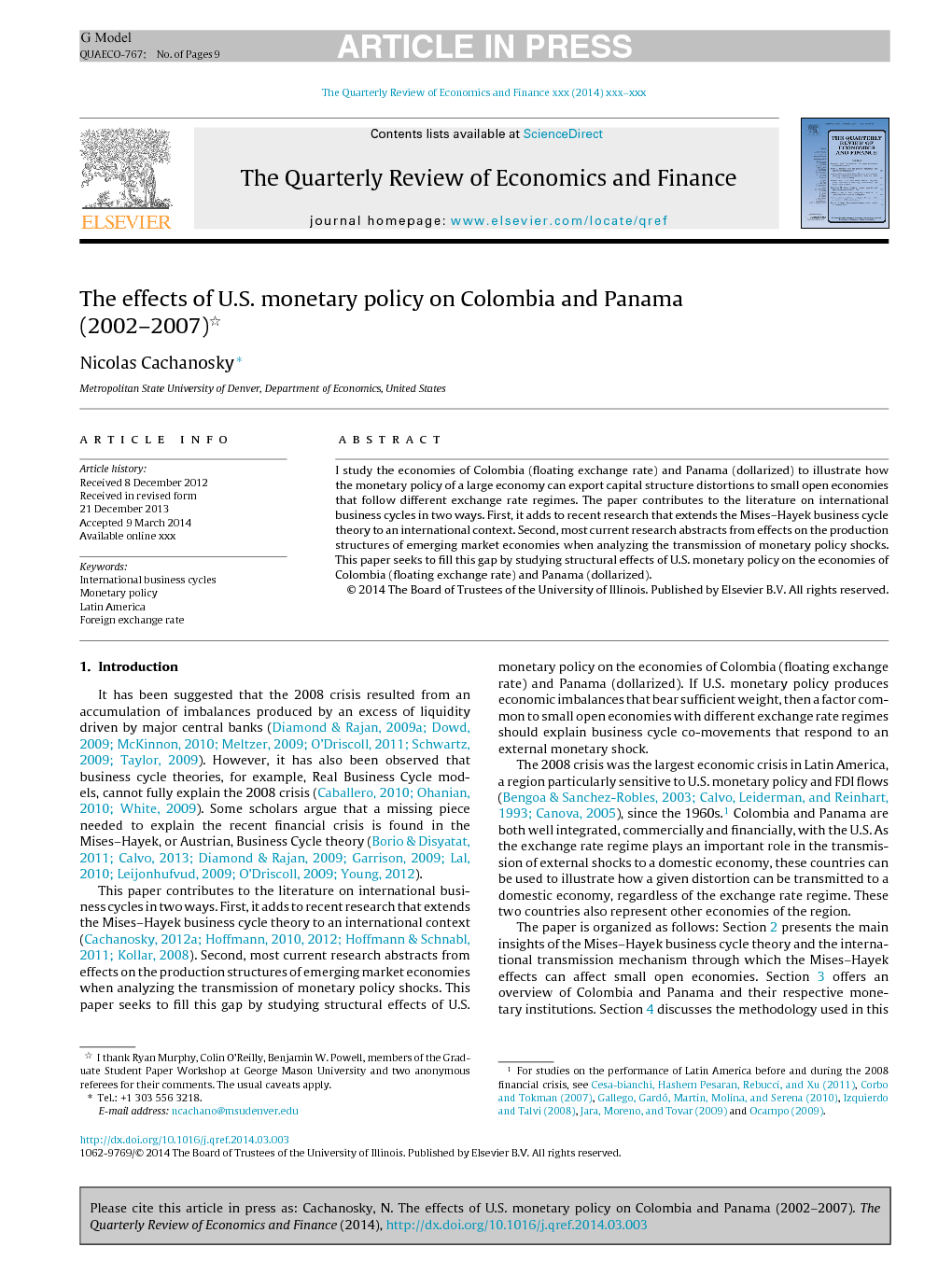It has been suggested that the 2008 crisis resulted from an accumulation of imbalances produced by an excess of liquidity driven by major central banks (Diamond and Rajan, 2009a, Dowd, 2009, McKinnon, 2010, Meltzer, 2009, O’Driscoll, 2011, Schwartz, 2009 and Taylor, 2009). However, it has also been observed that business cycle theories, for example, Real Business Cycle models, cannot fully explain the 2008 crisis (Caballero, 2010, Ohanian, 2010 and White, 2009). Some scholars argue that a missing piece needed to explain the recent financial crisis is found in the Mises–Hayek, or Austrian, Business Cycle theory (Borio and Disyatat, 2011, Calvo, 2013, Diamond and Rajan, 2009, Garrison, 2009, Lal, 2010, Leijonhufvud, 2009, O’Driscoll, 2009 and Young, 2012).
This paper contributes to the literature on international business cycles in two ways. First, it adds to recent research that extends the Mises–Hayek business cycle theory to an international context (Cachanosky, 2012a, Hoffmann, 2010, Hoffmann, 2012, Hoffmann and Schnabl, 2011 and Kollar, 2008). Second, most current research abstracts from effects on the production structures of emerging market economies when analyzing the transmission of monetary policy shocks. This paper seeks to fill this gap by studying structural effects of U.S. monetary policy on the economies of Colombia (floating exchange rate) and Panama (dollarized). If U.S. monetary policy produces economic imbalances that bear sufficient weight, then a factor common to small open economies with different exchange rate regimes should explain business cycle co-movements that respond to an external monetary shock.
The 2008 crisis was the largest economic crisis in Latin America, a region particularly sensitive to U.S. monetary policy and FDI flows (Bengoa and Sanchez-Robles, 2003, Calvo et al., 1993 and Canova, 2005), since the 1960s.1 Colombia and Panama are both well integrated, commercially and financially, with the U.S. As the exchange rate regime plays an important role in the transmission of external shocks to a domestic economy, these countries can be used to illustrate how a given distortion can be transmitted to a domestic economy, regardless of the exchange rate regime. These two countries also represent other economies of the region.
The paper is organized as follows: Section 2 presents the main insights of the Mises–Hayek business cycle theory and the international transmission mechanism through which the Mises–Hayek effects can affect small open economies. Section 3 offers an overview of Colombia and Panama and their respective monetary institutions. Section 4 discusses the methodology used in this paper. Section 5 presents and discusses our empirical results. Section 6 comments on the policy implications of the findings of this paper and concludes.
The fact that the 2008 financial crisis occurred following a period of low inflation points to the fact that price stability is not sufficient to prevent the distortions discussed in this paper. Because distortions in the production structure can cause future problems, even in the absence of inflationary pressures, there are policy implications to consider. In particular, it is clear that the objective of price stability is insufficient.
Another source of economic imbalance arises from central banks’ efforts to offset deflation caused by productivity gains. In particular, a price stability rule does not distinguish between benign (or good) deflation and malign (or bad) deflation. For price stability to equal monetary equilibrium, there should be no productivity gains; hence, price stability as a guide to monetary policy is no guarantee that a stable price level does not conceal economic imbalances. In the presence of productivity gains, a policy of price stabilization does not prevent inflation; it transfers it from the prices of final goods those of factors of production. Excess money supply persists but is channeled differently. Selgin, Beckworth, and Bahadir (2011) identify this problem after 2002 with a monetary policy that kept the price level stable by offsetting productivity gains. Propositions taking into account this issue have been discussed under the label of “productivity norm,” “nominal income” and “NGDP (nominal GDP) targeting” (Beckworth, 2008, Selgin, 1990, Selgin, 1997, Sumner, 2012 and White, 2007).13
The structural imbalances discussed in the paper add to our understanding of international monetary policy effects and business cycles and invite further research. Is there a superior norm to price level stability as a guide for monetary policy? Do other regions and crises show similar distortions? How do these effects impact tradable versus non-tradable sectors? What effects are produced in labor markets? Do these imbalances have any bearing on co-movements of business cycles across countries with different exchange rate regimes? Finally, what monetary policy would minimize economic distortions?


